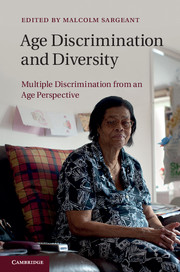Book contents
- Frontmatter
- Contents
- Figures
- Tables
- Contributors
- 1 Ageism and age discrimination
- 2 Multiple discrimination
- 3 Older women, work and the impact of discrimination
- 4 Still disadvantaged? Women in modern pension systems
- 5 Ageing and social class: towards a dynamic approach to class inequalities in old age
- 6 Age, sexual orientation and gender identity
- 7 Age and ethnicity
- 8 Disability and age discrimination
- 9 New approaches for understanding inequalities in service use among older people
- Index
- References
6 - Age, sexual orientation and gender identity
Published online by Cambridge University Press: 05 August 2011
- Frontmatter
- Contents
- Figures
- Tables
- Contributors
- 1 Ageism and age discrimination
- 2 Multiple discrimination
- 3 Older women, work and the impact of discrimination
- 4 Still disadvantaged? Women in modern pension systems
- 5 Ageing and social class: towards a dynamic approach to class inequalities in old age
- 6 Age, sexual orientation and gender identity
- 7 Age and ethnicity
- 8 Disability and age discrimination
- 9 New approaches for understanding inequalities in service use among older people
- Index
- References
Summary
Introduction
To be an older bisexual, gay, lesbian or transgender person is potentially to suffer from multiple discrimination. Terry Kaelbar, Executive Director of SAGE (Senior Action in a Gay Environment) summed up the issues in the USA and elsewhere:
Aging for GLBT seniors is informed by discrimination and anti gay bigotry, which impacts our ability and willingness to access needed programs and services as we age. It is informed by the fact that we, by and large, age as single people without the traditional familial supports of a spouse or children, supports available to the vast majority of heterosexual seniors, which makes us more reliant on the programs that we are not so willing to access. GLBT aging is informed by . . . our invisibility; with care providers who assume that all old people are straight, one of many heterosexist assumptions.
The subject of this chapter is older people who are lesbian, gay, bisexual or transgender and the disadvantage that they suffer because of the combination of their age and their sexual preferences/sexual identity. The acronyms LGB and LGBT are used to identify all these groups who are united in the sense that they are identified by their sexual orientation. This at least is the case with lesbians, gay men and bisexuals and may be the case with transgender people. Transgenders are usually included in the grouping but do have significantly different issues to deal with.
- Type
- Chapter
- Information
- Age Discrimination and DiversityMultiple Discrimination from an Age Perspective, pp. 111 - 131Publisher: Cambridge University PressPrint publication year: 2011

